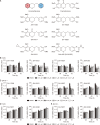Cremastranone-Derived Homoisoflavanes Suppress the Growth of Breast Cancer Cells via Cell Cycle Arrest and Caspase-Independent Cell Death
- PMID: 37226044
- PMCID: PMC10468425
- DOI: 10.4062/biomolther.2023.057
Cremastranone-Derived Homoisoflavanes Suppress the Growth of Breast Cancer Cells via Cell Cycle Arrest and Caspase-Independent Cell Death
Abstract
Breast cancer is the most common cancer and a frequent cause of cancer-related deaths among women wordlwide. As therapeutic strategies for breast cancer have limitations, novel chemotherapeutic reagents and treatment strategies are needed. In this study, we investigated the anti-cancer effect of synthetic homoisoflavane derivatives of cremastranone on breast cancer cells. Homoisoflavane derivatives, SH-17059 and SH-19021, reduced cell proliferation through G2/M cell cycle arrest and induced caspase-independent cell death. These compounds increased heme oxygenase-1 (HO-1) and 5-aminolevulinic acid synthase 1 (ALAS1), suggesting downregulation of heme. They also induced reactive oxygen species (ROS) generation and lipid peroxidation. Furthermore, they reduced expression of glutathione peroxidase 4 (GPX4). Therefore, we suggest that the SH-17059 and SH-19021 induced the caspase-independent cell death through the accumulation of iron from heme degradation, and the ferroptosis might be one of the potential candidates for caspase-independent cell death.
Keywords: Anti-cancer; Breast cancer; Caspase-independent cell death; Cell cycle arrest; Cremastranone; Homoisoflavane.
Figures





Similar articles
-
Synthetic Homoisoflavane Derivatives of Cremastranone Suppress Growth of Colorectal Cancer Cells through Cell Cycle Arrest and Induction of Apoptosis.Biomol Ther (Seoul). 2022 Nov 1;30(6):576-584. doi: 10.4062/biomolther.2022.090. Epub 2022 Aug 8. Biomol Ther (Seoul). 2022. PMID: 35934668 Free PMC article.
-
A Novel Derivative of Curcumol, HCL-23, Inhibits the Malignant Phenotype of Triple-Negative Breast Cancer and Induces Apoptosis and HO-1-Dependent Ferroptosis.Molecules. 2023 Apr 12;28(8):3389. doi: 10.3390/molecules28083389. Molecules. 2023. PMID: 37110625 Free PMC article.
-
Erratum to "Synthetic Homoisoflavane Derivatives of Cremastranone Suppress Growth of Colorectal Cancer Cells through Cell Cycle Arrest and Induction of Apoptosis" [Biomol. Ther. 30 (2022) 576-584].Biomol Ther (Seoul). 2023 Jan 1;31(1):139. doi: 10.4062/biomolther.2022.005. Epub 2022 Dec 19. Biomol Ther (Seoul). 2023. PMID: 36535633 Free PMC article. No abstract available.
-
A Dual Role of Heme Oxygenase-1 in Cancer Cells.Int J Mol Sci. 2018 Dec 21;20(1):39. doi: 10.3390/ijms20010039. Int J Mol Sci. 2018. PMID: 30583467 Free PMC article. Review.
-
Lipid Peroxidation-Dependent Cell Death Regulated by GPx4 and Ferroptosis.Curr Top Microbiol Immunol. 2017;403:143-170. doi: 10.1007/82_2016_508. Curr Top Microbiol Immunol. 2017. PMID: 28204974 Review.
Cited by
-
Advancing vaccine-based immunotherapy in glioblastoma treatment.Neurooncol Adv. 2025 Jun 24;7(1):vdaf135. doi: 10.1093/noajnl/vdaf135. eCollection 2025 Jan-Dec. Neurooncol Adv. 2025. PMID: 40756669 Free PMC article. Review.
-
Remodeling of tumour microenvironment: strategies to overcome therapeutic resistance and innovate immunoengineering in triple-negative breast cancer.Front Immunol. 2024 Dec 10;15:1455211. doi: 10.3389/fimmu.2024.1455211. eCollection 2024. Front Immunol. 2024. PMID: 39720730 Free PMC article. Review.
-
Exploring the Antiangiogenic and Anti-Inflammatory Potential of Homoisoflavonoids: Target Identification Using Biotin Probes.Biomolecules. 2024 Jun 30;14(7):785. doi: 10.3390/biom14070785. Biomolecules. 2024. PMID: 39062499 Free PMC article. Review.
-
Isoliquiritigenin Induces Apoptosis via ROS-Mediated Inhibition of p38/mTOR/STAT3 Pathway in Human Melanoma Cells.Biomol Ther (Seoul). 2025 Mar 1;33(2):378-387. doi: 10.4062/biomolther.2024.118. Epub 2025 Feb 12. Biomol Ther (Seoul). 2025. PMID: 39933948 Free PMC article.
References
-
- Basavarajappa H. D., Lee B., Lee H., Sulaiman R. S., An H., Magaña C., Shadmand M., Vayl A., Rajashekhar G., Kim E. Y., Suh Y. G., Lee K., Seo S. Y., Corson T. W. Synthesis and biological evaluation of novel homoisoflavonoids for retinal neovascularization. J. Med. Chem. 2015;58:5015–5027. doi: 10.1021/acs.jmedchem.5b00449. - DOI - PMC - PubMed
-
- Basavarajappa H. D., Sulaiman R. S., Qi X., Shetty T., Sheik Pran Babu S., Sishtla K. L., Lee B., Quigley J., Alkhairy S., Briggs C. M., Gupta K., Tang B., Shadmand M., Grant M. B., Boulton M. E., Seo S. Y., Corson T. W. Ferrochelatase is a therapeutic target for ocular neovascularization. EMBO Mol. Med. 2017;9:786–801. doi: 10.15252/emmm.201606561.3e824506a6224c1eb5ab5fcfef835898 - DOI - PMC - PubMed
LinkOut - more resources
Full Text Sources
Research Materials

